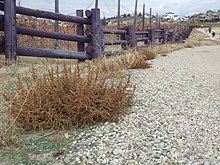| Amaranthus albus | |
|---|---|

| |

| |
| Scientific classification | |
| Kingdom: | Plantae |
| Clade: | Tracheophytes |
| Clade: | Angiosperms |
| Clade: | Eudicots |
| Order: | Caryophyllales |
| Family: | Amaranthaceae |
| Genus: | Amaranthus |
| Species: | A. albus
|
| Binomial name | |
| Amaranthus albus L. 1759 not Thunb. 1823 nor Rodschied ex F.Dietr. 1824
| |
| Synonyms[1] | |
| |
Amaranthus albus is an annual species of flowering plant. It is native to the tropical Americas but a widespread introduced species in other places, including Europe, Africa and Australia.[2][3][4]
Common names include common tumbleweed,[5] tumble pigweed,[5] tumbleweed,[5] prostrate pigweed,[6] pigweed amaranth, white amaranth[5] and white pigweed.[5]
Amaranthus albus is an annual herb up to 50 cm (20 inches) tall, forming many branches. Larger specimens turn into tumbleweeds when they die and dry out. The plant creates small, greenish flowers in clumps in the axils of the leaves. Male and female flowers are mixed together in the same clump.[2][7]
In Cambodia, the leaves of the plant (which is known as phti sâ, Khmer language) is used as pig-feed, and are sometimes cooked and eaten by people.[8]
- ^ "The Plant List: A Working List of All Plant Species". Retrieved 2 June 2015.
- ^ a b Flora of China, 白苋 bai xian Amaranthus albus Linnaeus
- ^ Altervista Flora Italiana, Amaranto bianco, weißer Fuchsschwanz, carurú-branco, Amaranthus albus L. includes photos and European distribution map
- ^ Atlas of Living Australia
- ^ a b c d e "Amaranthus albus". Germplasm Resources Information Network. Agricultural Research Service, United States Department of Agriculture. Retrieved 20 July 2014.
- ^ USDA, NRCS (n.d.). "Amaranthus albus". The PLANTS Database (plants.usda.gov). Greensboro, North Carolina: National Plant Data Team. Retrieved 7 January 2016.
- ^ Flora of North America, Tumbleweed amaranth, tumble pigweed, white amaranthAmaranthus albus Linnaeus, Syst. Nat. ed. 10. 2: 1268. 1759.
- ^ Pauline Dy Phon (2000). Plants Utilised In Cambodia/Plantes utilisées au Cambodge. Phnom Penh: Imprimerie Olympic. p. 121.